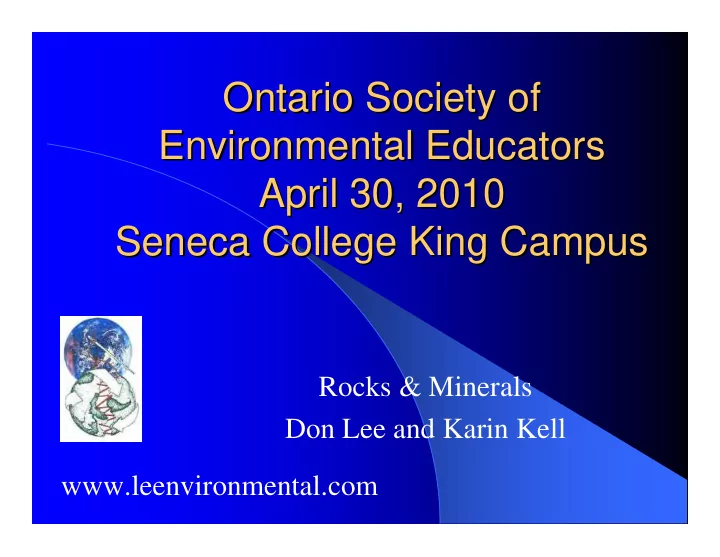

Ontario Society of Ontario Society of Environmental Educators Environmental Educators April 30, 2010 April 30, 2010 Seneca College King Campus Seneca College King Campus Rocks & Minerals Don Lee and Karin Kell www.leenvironmental.com
Summary Summary � Tools of the geologists � Safety � Classification flow chart � Define element, compound, mineral, rock � Properties of minerals � Show samples � Rock classification
GEOLOGIST TOOLS GEOLOGIST TOOLS
Classroom Safety Classroom Safety � Check for allergies � Wash hands if handling samples � Check with board policy about restricted and banned substances � STAO Be Safe and Stay Safe Documents
FLOW DIAGRAM of minerals FLOW DIAGRAM of minerals Elements Chemical Compounds Minerals Rocks
Definitions Definitions � Element = one type of atom. � Chemical Compound = 2 or more elements in definite ratio � Mineral = 1 or more elements that have specific properties � Rocks = 1 or more minerals, compose earth’s crust
Application to Grade 4 Application to Grade 4 *Cross Curricular – Language & Math *Interactive Groups – Roles and Levels *Pre-Assessment, Formative, Summative - Activate Prior Knowledge: Organizer sample KWL (Know, Want, Learned) Shared Experiences, Guided Reading, Computers Uses of Rocks or Minerals (Daily Awareness)
Properties of Minerals Properties of Minerals � Colour/Streak � Lustre/Transparency � Hardness/Tenacity � Density � Fracture/Cleavage � Crystal structure � Special properties
Same mineral may have different colours Quartz
Hexagonal Crystals Quartz
Solution Quartz
Quartz – Herkimer Diamond in a vug
Sulphur (yellow) in a vein
Geode to Agate
Galena cubes Pyrite cubes
Garnet: Almandime - hexoctahedral
Dogtooth Calcite
Dogtooth Calcite
Pink Calcite
Pink Calcite
Malachite
Polished Malachite
Polished Malachite
Sand Selenite
Barite
Tabular Crystal: Wulfenite
Gemstone : Ruby
Crysoberyl
Rock Cycle
Metamorphic Sedimentary Igneous
Wentworth scale of particle size φ scale size range Wentworth range Wentworth name other names -8 to - ∞ 256- ∞ kk 10.1- ∞ in boulder gravel -6 to -8 64 – 256 mm 2.5 – 10.1 in cobble gravel -2 to -6 4 – 64 mm 0.157 – 2.5 in pebble gravel -1 to -2 2 – 4 mm 0.079 – 0.157 in granule gravel 0 to -1 1 – 2 mm 0.039 – 0.079 in very coarse sand sand 1 to 0 0.5 – 1 mm 0.020 – 0.039 in coarse sand sand 2 to 1 0.25 – 0.5 mm 0.010 – 0.020 in medium sand sand 3 to 2 125 – 250 µ m 0.0049 – 0.010 in fine sand sand 4 to 3 62.5 – 125 µ m 0.0025 – 0.0049 in very fine sand sand 5 to 4 3.9 – 62.5 µ m 0.00015 – 0.0025 in silt mud ∞ to 8 1/ ∞ -3.9 µ m 1/ ∞ – 0.00015 in clay mud ∞ to 10 1/ ∞ -1 µ m 1/ ∞ – 0.000039 in colloid mud
Geology Lab Geology Lab Presenters: DON LEE AND KARIN KELL www.leenvironmental.com
Why is the sample bottom left encapsulated in this photo?
Asbestos is a Designated Substance that cannot be brought into schools. Internet has excellent photos.
Rock Humour
For more information: Contact Don Lee Lee Environmental Education & Consulting www.leenvironmental.com
Recommend
More recommend